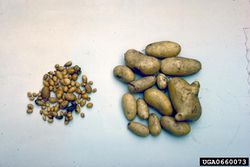Potato spindle tuber viroid
| Literature database |
|---|
| 169 articles sorted by: |
| • year (descending) |
| • research topics |
| • countries/regions |
| • host plants |

Author(s): William M. Brown Jr.
Source: IPM Images
Potato spindle tuber viroid (PSTVd)
The viroid is widespread and infects several solanaceous crops, in particular potatoes and tomatoes. The characteristic symptoms on potatoes include small, spindle-shaped tubers with prominent eyes. On tomatoes, the viroid causes stunting, leaf chlorosis, leaf curling and purpling of the older leaves. Asymptomatic infections have been also reported. Crop losses can reach 50% or more. It can be easily transmitted mechanically, spreading to adjacent plants. Infected potato tubers and tomato seeds can result in long-distance spread of the disease. Management involves the careful removal of infected plants and the use of viroid-free tubers and seeds.

Author(s): William M. Brown Jr.
Source: IPM Images
PSTVd was the first viroid discovered and described by T.O. Diener in 1971. The viroid replicates in the nucleus and typically contains 359 nucleotides. It is the type species of the genus Pospiviroid and the family Pospiviroidae. Several strains of the viroid have been described which differ in their virulence. Some strains can kill the host plants.
| Vernacular names | |
|---|---|
| • Deutsch: | Kartoffelspindelknollen-Viroid |
| • English: | Potato spindle tuber viroid |
| • Français: | viroïde de la maladie des tubercules en fuseau |

Author(s): H.J. Larsen
Source: Wikimedia Commons